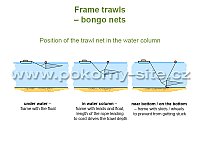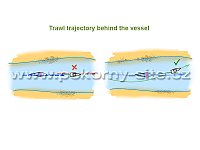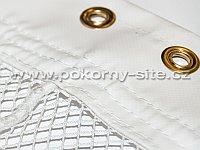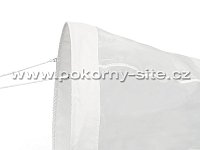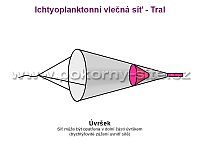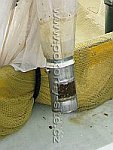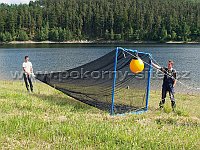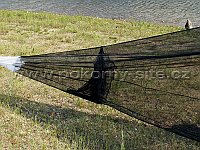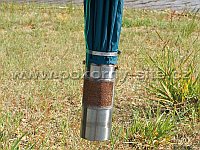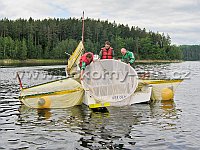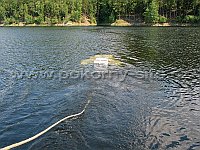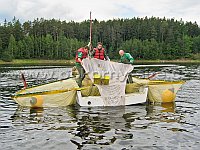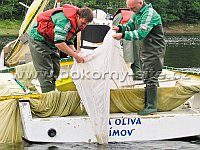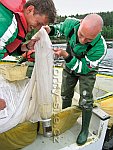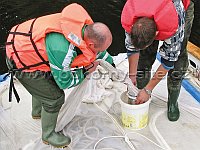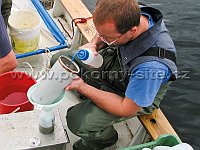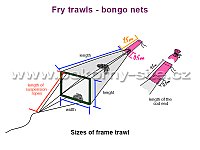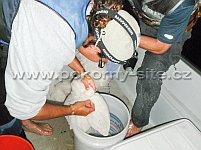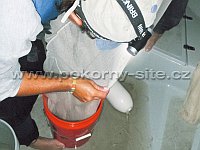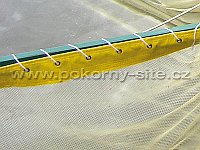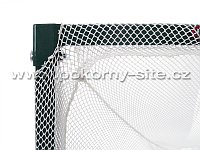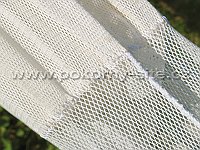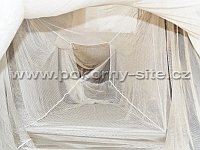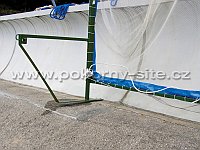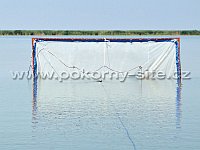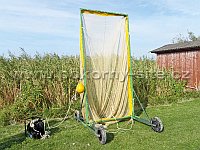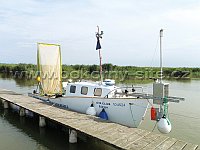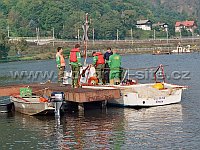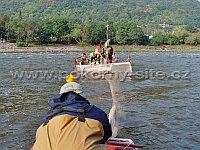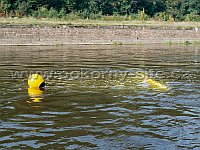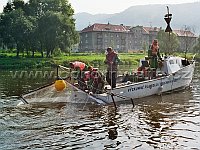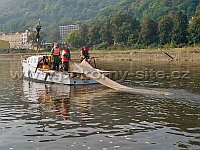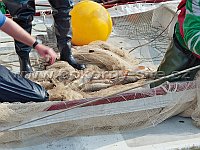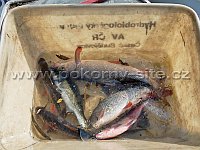Fishing nets - Active fishing gear
Frame trawls – bongo nets
universal net and sampling method
Usage:
- sampling of invertebrates
- sampling of fi sh eggs and early fry stages
- sampling of earliest fry stages
- sampling of 0+ fish
Advantages of trawls – frame trawls:
- possible to sample in a wide range of depths
- can sample a large water volume
- minimal damage to fish
- mobile and easy to control
- obtain information about the precise fi sh fry composition and abundance in the sampled time and area
- easy to compute results into the units of sampled water volume
General principles for successful sampling:
- suffi ciently strong and fast vessel to the size and design of the net used
- the speed must be close to 1 m/s (Cech et al. 2005)
- sampled trajectory is measured with a GPS tracker
- sampled volume of water is measured most precisely with flowmeter
- sufficient size – design of the net
- correct mesh size
- use draught ropes with a suitable length
- trawl trajectory must not copy the vessel trajectory
- the net has to be placed correctly in the water
- trawl has to be balanced correctly
- suitably chosen accessories for the net and frame – fl oats, leads, wheels or skids
Profile
display / hide whole profile
Msc. Tomáš Juza Ph.D. (*5. 4. 1981)
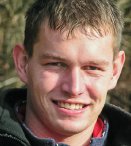 I completed my studies in the Faculty of Science at the University of South Bohemia in České Budějovice (2001 – 2011). Since 2007, I have worked in Institute of Hydrobiology of the Academy of Sciences of the Czech Republic. My main research interests are the ecology of fi sh fry in reservoirs and lakes, methodology of fi sh sampling and the effi ciency of sampling gears. I have been on internships in the USA, Canada and Norway to learn about trawl sampling methodology. Currently, the challenge is evaluating the selectivity of trawls for various fi sh species and sizes living in the lentic waters. Frame trawls, ichtyoplankton nets and bongo nets are commonly used to study of fi sh fry ecology in reservoirs and lakes. My colleagues and I have evaluated trawl effi ciency and standardized net sizes for sampling. Bongo nets with a 3 x 3 m frame size, 6 mm mesh size in front and 4 mm mesh in the rear became a standard net for fry sampling in reservoirs and lakes. This net can sample at night without any apparent fi sh escape reaction. Thanks to the size of the net, it is easy to manipulate and does not require an extremely powerful draught vessel. It is also possible to sample in various depths of the water column. Bongo nets are useful for collecting quantitative and qualitative characteristics of fi sh fry communities in the open water of reservoirs and lakes. With this type of net I have conducted ecological studies of fi sh fry distribution and behavior, all results are published in high impact journals. Also, it revealed some phenomena of certain fi sh species ecology. I offer consultations about the usefulness of fi sh fry sampling techniques. I also offer fi sh fry surveys in all habitats in reservoirs and lakes.
I completed my studies in the Faculty of Science at the University of South Bohemia in České Budějovice (2001 – 2011). Since 2007, I have worked in Institute of Hydrobiology of the Academy of Sciences of the Czech Republic. My main research interests are the ecology of fi sh fry in reservoirs and lakes, methodology of fi sh sampling and the effi ciency of sampling gears. I have been on internships in the USA, Canada and Norway to learn about trawl sampling methodology. Currently, the challenge is evaluating the selectivity of trawls for various fi sh species and sizes living in the lentic waters. Frame trawls, ichtyoplankton nets and bongo nets are commonly used to study of fi sh fry ecology in reservoirs and lakes. My colleagues and I have evaluated trawl effi ciency and standardized net sizes for sampling. Bongo nets with a 3 x 3 m frame size, 6 mm mesh size in front and 4 mm mesh in the rear became a standard net for fry sampling in reservoirs and lakes. This net can sample at night without any apparent fi sh escape reaction. Thanks to the size of the net, it is easy to manipulate and does not require an extremely powerful draught vessel. It is also possible to sample in various depths of the water column. Bongo nets are useful for collecting quantitative and qualitative characteristics of fi sh fry communities in the open water of reservoirs and lakes. With this type of net I have conducted ecological studies of fi sh fry distribution and behavior, all results are published in high impact journals. Also, it revealed some phenomena of certain fi sh species ecology. I offer consultations about the usefulness of fi sh fry sampling techniques. I also offer fi sh fry surveys in all habitats in reservoirs and lakes.
Contact: +420 733 373 139, tomas.juza@seznam.cz
http://www.fi shecu.cz/staff-members/juza
Relevant fi sh fry sampling gear publications:
- Juza, T., Kubecka, J. 2007. The efficiency of three fry trawls for sampling the freshwater fry community. Fisheries Research 85(3), 285-290.
- Juza, T., Cech, M., Kubecka, J., Vašek, M., Peterka, J., Matena, J. 2010. The influence of the trawl mouth opening size and net colour on catch efficiency during sampling of early fish stages. Fisheries Research 105, 125-133.
- Juza, T., Cech, M., Kubecka, J., Vašek, M., Peterka, J., Kratochvíl, M., Frouzová, J., Matena, J. 2012. The influence of the trawl mouth opening size and net colour on catch efficiency during sampling of early stages of perch (Perca fluviatilis) and pikeperch (Sander lucioperca) in the bathypelagic layer of a canyon-shaped reservoir. Fisheries Research 123-124: 21-25.
- Juza, T., Rakowitz, G., Draštík, V., Blabolil, P., Herzig, A., Kratochvíl, M., Muška, M., Ríha, M., Sajdlová, Z., Kubecka, J. 2013. Avoidance reactions of fish in the trawl mouth opening in a shallow and turbid lake at night. Fisheries Research 147: 154-160.
- Juza, T., Vašek, M., Kratochvíl, M., Blabolil, P., Cech, M., Draštík, V., Frouzová, J., Muška, M., Peterka, J., Prchalová, M., Ríha, M., Tušer, M., Kubecka, J. 2014. Chaos and stability of age-0 fish assemblages in a temperate deep reservoir: unpredictable success and stable habitat use. Hydrobiologia 724: 217-234.
Position of the trawl net in the water column
Trawl trajectory behind the vessel
Ichtyoplankton net – trawl
ichtyoplankton nets are included in trawl nets
it is possible to sample the whole water column
Usage:
- sampling of large invertebrates in the open water
- sampling of fi sh eggs, larvae and early fi sh stages
- sampling of the earliest fish stages
Frame design
- CIRCULAR FRAME WITH 90 cm DIAMETER
- circular frame is made from steel wire
- frame has 3 binding rings
- circle diameter 90 cm
- wire diameter 8 mm
- powder coated
- DETACHABLE FRAME MADE FROM SQUARE TUBES
- frame size 2 x 2 m
- frame is detachable in corners
- frame wide 3 m and more is divided into more parts
- frame has 4 – 6 binding rings
- powder coated
| MATERIAL | MESH SIZE (in mm) | FRAME DIAMETER (in m) | LENGTH (in m) |
|---|---|---|---|
| Tyl | 2 x 2 | 2 | 6 |
| Tyl | 2 x 2 | square-shaped 2 x 2 | 6 |
Net design
- polyester net with 2 mm mesh size
- colors: black, white
- net length 8 or 10 m
- NET HAS A PROTECTIVE HEM MADE FROM POLYAMIDE OR PVC
- option 1: frame is freely threaded through the hem
- option 2: frame is attached to the inner metal rings of the hem with the cord
- option 3: frame is fi rmly sewn into the hem
- NET ENDING
- option 1: funnel and detachable metal container for collecting
- option 2: funnel and cod end
- option 3: cod end
Funnel
possible to sew the funnel inside the net:
- funnel does not prevent the catch from going to the rear part of the net
- funnel prevents from the catch escaping
- when the trawl slows down
- when the trawl is pulled to the vessel (or moves slowly)
- when the net does not move
Outlet end
possible net ending:
- metal collecting container
- all catch is fl ushed to the collecting container when the net is pulled out of the water
- detaching is bayonet based mechanism - cod end from dense mesh size
- after the net is pulled out of the water, untie the net and wash out the catch into prepared container
- Ichtyoplankton net - trawl
- frame 2 x 2 m, detachable construction
- tyl net – 4 m length, funnel sewn in the net
- metal collecting container
- Ichtyoplankton net - trawl
- frame, ring diameter 2 m, wire thickness 12 mm
- tyl net – 6 m length, funnel sewn in the net
- metal collecting container
Fry trawls – bongo nets
- bongo nets belong to the category of trawl nets
- can sample at all depths
Usage:
- sampling of 0+ fi sh and adults
Frame design
- DETACHABLE FRAME MADE FROM SQUARE TUBES
- sizes: 3 x 1.5 m, 3 x 3 m, 6 x 3 m
- can detach frame in corners
- frame wide 3 m and more is divided into more parts
- frame has 4 – 6 binding rings
- powder coated
Net design
- polyamide net
- thread thickness 201/4 – 6
- mesh size 4 and 6 mm
- white color
- net length depends on frame size – 9.5, 10.5, 16.5 m
- NET HEM IS MADE FROM PVC
- option 1: frame is freely threaded through the hem
- option 2: frame is attached to the inner metal rings of the hem with the cord
- FRAME IS THREADED THROUGH THE HEM
- NET ENDING
- funnel and cod end, length 1.5 m, mesh size 4 mm
Funnel
- funnel prevents the catch from escaping
- when the trawl slows down
- when the trawl is pulled to the vessel (or moves slowly)
- when net does not move
Time-tested standard sizes of frame trawls made for research institutes:
| MESH SIZE OF THE BODY / MESH SIZE OF THE COD END(in m) | WIDTH (in m) | HEIGHT | LENGTH OF SUSPENSION ROPES (in m) | LENGTH OF THE TRAWL BODY (in m) | LENGTH OF THE FUNNEL (in m) | COD END (in m) |
|---|---|---|---|---|---|---|
| 6 / 4 | 3 | 1.5 | 1.85 | 9.5 | 0.5 | 1.5 |
| 6 / 4 | 3 | 3 | 2.9 | 10.5 | 0.5 | 1.5 |
| 6 / 4 | 6 | 3 | 4.55 | 16.5 | 0.5 | 1.5 |
Frame trawl has skids or wheels according to the character of the bottom
- demonstration of benthic trawl sampling
Trawl nets are also suitable for scientific research

